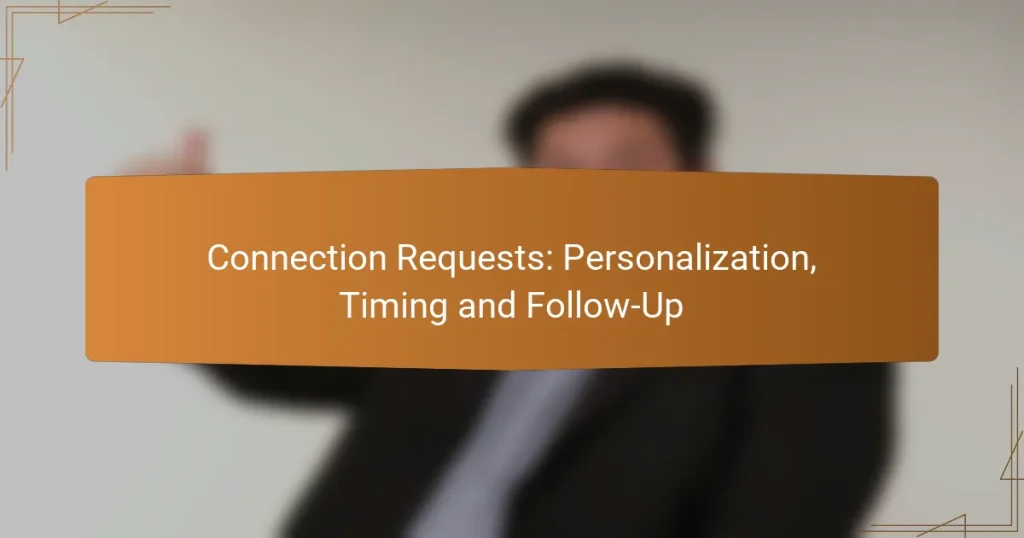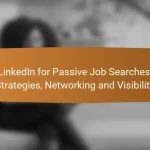Crafting personalized connection requests can greatly enhance your likelihood of acceptance, as it reflects genuine interest in the recipient. Additionally, timing your requests during weekdays and business hours can further improve engagement. Implementing effective follow-up strategies, such as sending thank-you messages and offering additional value, can solidify these connections and foster deeper relationships.
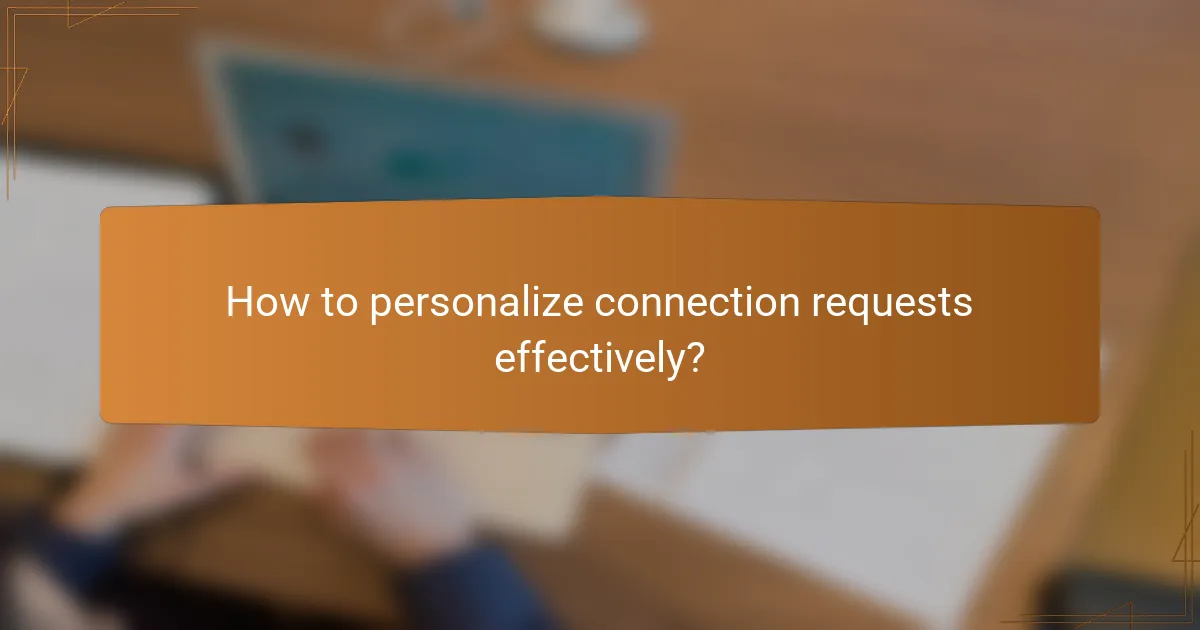
How to personalize connection requests effectively?
Personalizing connection requests can significantly increase your chances of acceptance. Tailoring your message to the recipient shows genuine interest and can create a more meaningful connection.
Use recipient’s name
Including the recipient’s name in your connection request is a simple yet effective way to personalize your message. It makes the request feel more direct and personal, rather than generic.
For example, instead of starting with “Hello,” use “Hi John.” This small change can make the recipient feel valued and more inclined to accept your request.
Reference mutual connections
Mentioning mutual connections can establish trust and credibility. If you share contacts, highlight them in your request to create a sense of familiarity.
For instance, you could say, “I noticed we both know Sarah Smith.” This not only personalizes your message but also provides a reason for the recipient to consider your request seriously.
Highlight shared interests
Identifying and mentioning shared interests can strengthen your connection request. This could be a common industry, professional goals, or hobbies.
For example, you might say, “I see we both have a passion for digital marketing.” This shows that you have something in common, making it easier for the recipient to relate to you.
Customize the message tone
Adjusting the tone of your message to match the recipient’s profile can enhance personalization. A friendly tone may work well for someone in a creative field, while a more formal tone might be appropriate for corporate professionals.
Pay attention to their LinkedIn profile or previous interactions to gauge the right tone. This alignment can make your request feel more authentic and respectful.
Include a specific reason for connecting
Clearly stating why you want to connect can make your request more compelling. Whether it’s to learn from their experience or discuss a specific project, being upfront about your intentions is key.
For example, you could write, “I admire your work in sustainable architecture and would love to connect to learn more about your approach.” This specificity shows that you have a genuine interest in the recipient’s expertise.

When is the best time to send connection requests?
The best time to send connection requests is when your target audience is most likely to engage, which typically falls during weekdays and business hours. Timing your requests strategically can significantly increase the chances of acceptance and meaningful interactions.
Weekdays during business hours
Sending connection requests on weekdays, particularly during business hours, aligns with when professionals are most active on networking platforms. Aim for mid-morning or early afternoon, as these times often see higher engagement rates.
Consider avoiding Mondays and Fridays, as professionals may be preoccupied with weekly planning or winding down for the weekend. Aiming for Tuesday to Thursday can yield better results.
After major industry events
Following major industry events, such as conferences or trade shows, is an opportune time to send connection requests. Attendees are often looking to expand their network after engaging discussions and presentations.
To maximize impact, personalize your requests by referencing the event or a specific conversation you had. This approach can create a more genuine connection and increase the likelihood of acceptance.
Before the end of the fiscal year
As the fiscal year approaches its end, professionals may be more open to networking for new opportunities or collaborations. This period often prompts individuals to reassess their connections and seek out new partnerships.
Consider timing your requests in the months leading up to the fiscal year-end, particularly in sectors where budget planning and project proposals are common. Highlighting mutual benefits in your connection request can enhance your chances of a positive response.
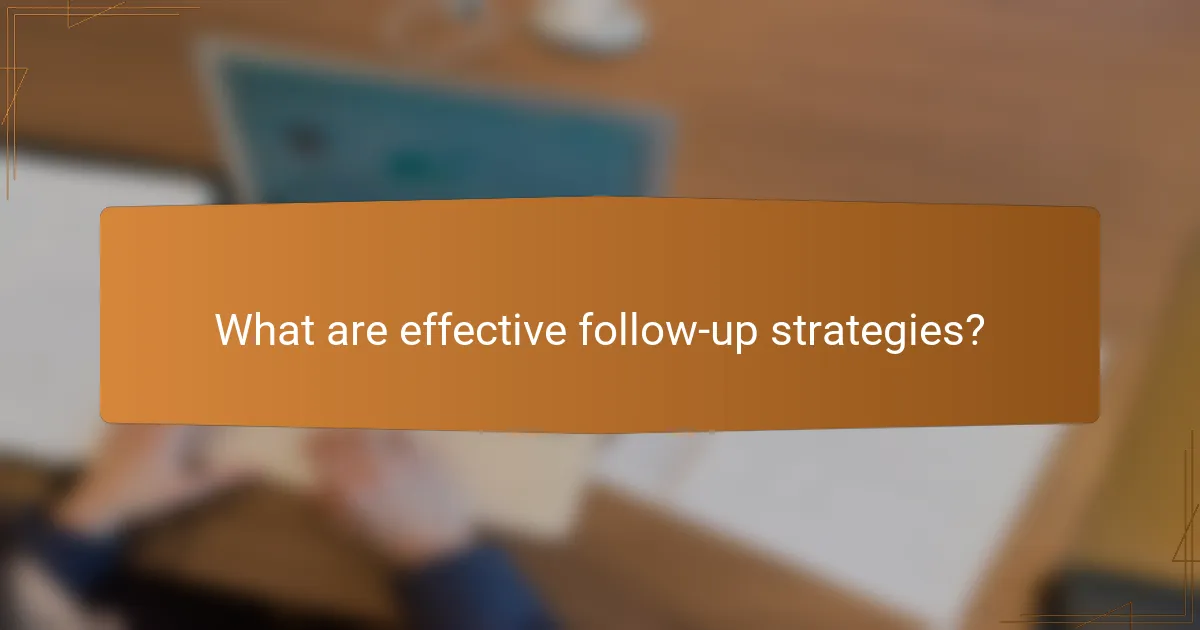
What are effective follow-up strategies?
Effective follow-up strategies enhance your connection requests by reinforcing relationships and demonstrating genuine interest. Key approaches include sending thank-you messages, providing additional value, and asking for meetings to deepen the engagement.
Send a thank-you message
Sending a thank-you message is a crucial first step after any interaction. A simple note expressing gratitude can leave a positive impression and strengthen your connection. Aim to send this message within 24 hours to ensure your communication is timely and relevant.
Keep your thank-you note concise and personalized. Mention specific details from your conversation to show attentiveness. For example, “Thank you for sharing your insights on digital marketing; I found them very helpful.”
Provide additional value
Offering additional value in your follow-up can set you apart and demonstrate your expertise. Share relevant articles, resources, or insights that align with the interests discussed during your initial interaction. This not only reinforces your connection but also positions you as a valuable contact.
Consider including a brief summary or key takeaways from the resource you share. For instance, if you send an article about industry trends, highlight the main points that might interest the recipient. This approach encourages further dialogue and engagement.
Ask for a meeting
Asking for a meeting is an effective way to deepen your connection and explore opportunities for collaboration. Be clear about your intentions and suggest specific times to meet, making it easier for the recipient to respond. Aim for a casual tone to make the invitation feel more approachable.
When proposing a meeting, consider the recipient’s schedule and preferences. Offering a choice of times can increase the likelihood of a positive response. For example, “Would you be available for a coffee chat next week on Tuesday or Thursday?” This shows respect for their time while expressing your eagerness to connect further.
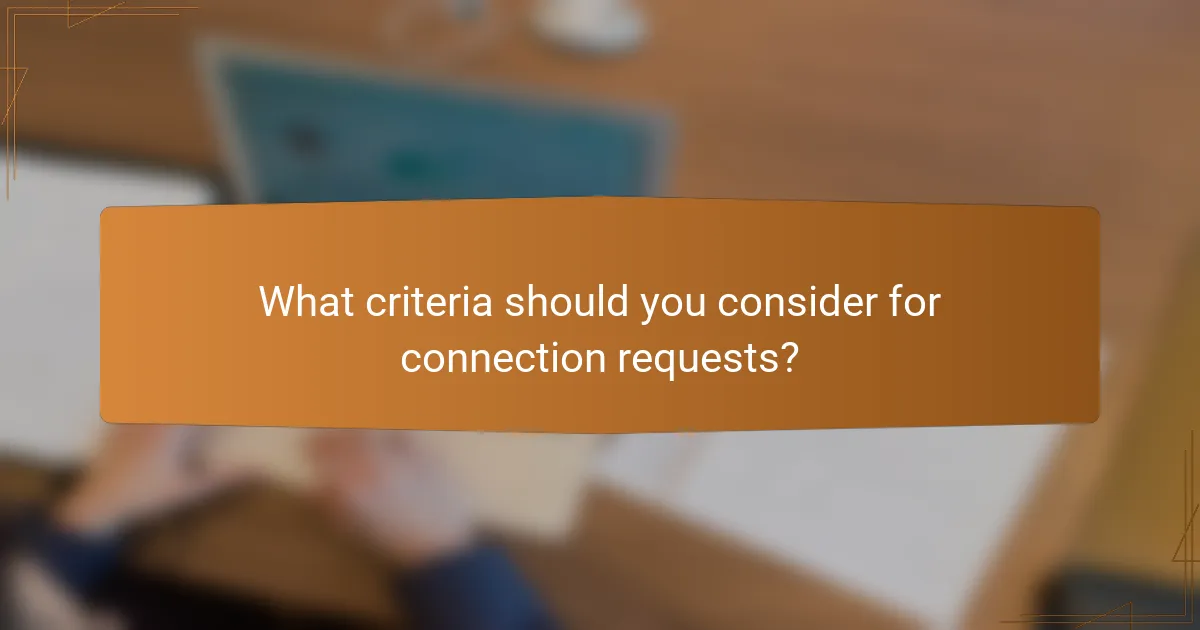
What criteria should you consider for connection requests?
When sending connection requests, consider professional relevance, geographic proximity, and industry alignment to enhance the likelihood of acceptance and meaningful engagement. Tailoring your requests based on these criteria can lead to more fruitful networking opportunities.
Professional relevance
Professional relevance refers to how closely your work aligns with the recipient’s field or expertise. When crafting a connection request, highlight shared interests, mutual contacts, or similar professional backgrounds to establish a common ground. This increases the chances of your request being accepted.
For example, if you are a marketing professional reaching out to someone in digital marketing, mentioning specific projects or skills you both share can strengthen your appeal. Aim to be concise yet specific about why connecting would be beneficial for both parties.
Geographic proximity
Geographic proximity can play a significant role in networking, especially for local opportunities or events. If you and the recipient are based in the same city or region, mention this in your request to create a sense of familiarity and relevance. Local connections often lead to in-person meetings or collaborations.
For instance, if you are in London and the recipient is also based there, you might reference local industry events or groups you both belong to. This shared location can foster a stronger connection and increase the likelihood of acceptance.
Industry alignment
Industry alignment involves connecting with individuals within the same or related sectors. This can facilitate knowledge sharing, collaboration, and potential job opportunities. When sending a connection request, emphasize your interest in their industry and how your backgrounds intersect.
For example, if you work in the tech sector and are reaching out to someone in the finance industry, you might discuss how technology is transforming financial services. This shows that you are not only interested in their work but also understand the broader context of your industries.
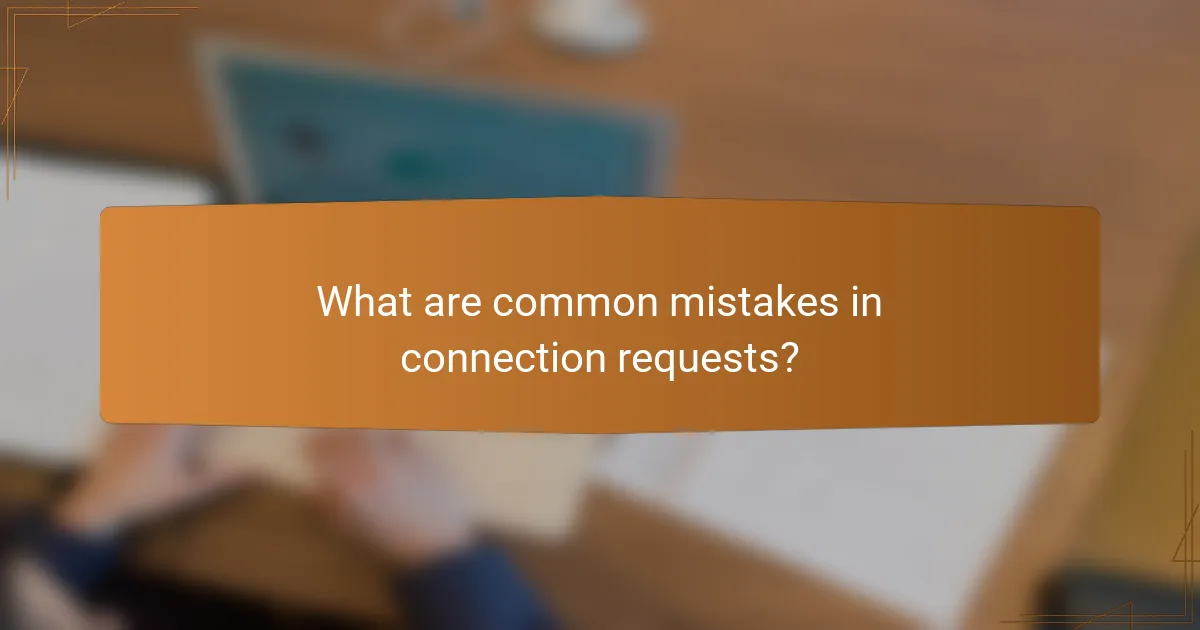
What are common mistakes in connection requests?
Common mistakes in connection requests include using generic messages, failing to personalize the request, and neglecting proper timing for follow-ups. These errors can lead to low acceptance rates and missed networking opportunities.
Using generic messages
Using generic messages in connection requests is a frequent mistake that can diminish the chances of acceptance. A message that lacks personalization often feels impersonal and may suggest that the sender is not genuinely interested in the recipient.
To improve your connection requests, take the time to customize your message. Mention a shared interest, mutual connections, or a specific reason for wanting to connect. For example, instead of saying “I’d like to connect,” you could say, “I enjoyed your article on digital marketing and would love to connect to discuss it further.”
Avoid templates that do not reflect the recipient’s unique profile. Personalization shows that you value the connection and are willing to invest effort into building a relationship, which can significantly increase your acceptance rate.
